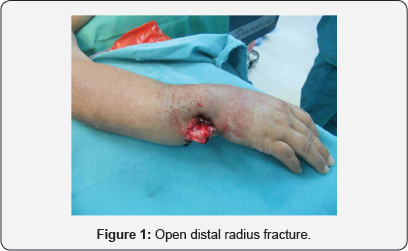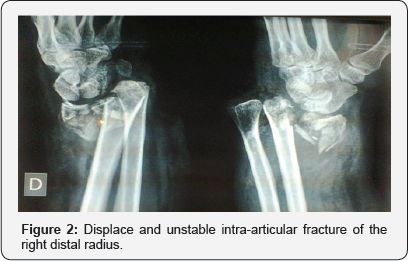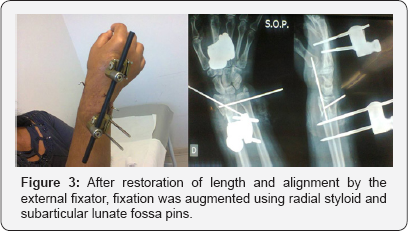Treatment of Open Distal Radius Fracture through External Fixation: A Case Report
Ricardo Monreal1*, Fernando Lopez Guevara2, Maria C Lopez Gil2 and Eilen Monreal3
1Centro Medico MEDEX, Republica de Panama 3065 2do piso, South America
2Las Tunas General Hospital, Las Tunas, Cuba
3School of Medicine, Ricardo Palma University, South America
Submission: July 30, 2017; Published: August 10, 2017
*Corresponding author: Ricardo Monreal, Centro Medico MEDEX, Republica de Panama 3065 2do piso, San Isidro, and Clinicas Maison de Sante,Ave. Chorrillos 171, Chorrillos. Lima, Peru, South America, Email: rmonreal59@yahoo.es
How to cite this article: Ricardo M, Fernando L G, Maria C L G, Eilen M. Treatment of Open Distal Radius Fracture through External Fixation: A Case Report. Ortho & Rheum Open Access 2017; 8(1): 555731. DOI: 10.19080/OROAJ.2017.08.555731
Abstract
The purpose of this article is to report radiographic, clinical, and functional outcome of a 52 year old woman who sustained an open comminuted and unstable fracture of the distal part of the right radius treated with early debridement and external fixation.
Keywords: Distal radius fracture; Open fractures, External fixator
Introduction
Open fractures are high-energy injuries that present with a spectrum of soft tissue and bony injury [1]. Open distal radial fractures are an uncommon mode of injury in the upper limb and there is little information in the literature regarding their management. Prevention of infection, healing of the fracture, and restoration of function are the primary objectives in the treatment of open fractures and notable differences have been reported in the management of open long bone and open hand fractures. The purpose of this study was to evaluate the outcome of a 52 year old woman with open fractures of the right distal radius treated with early debridement and external fixation.
Case Presentation

A 52-year-old woman presents to the emergency room 3 hours after a car accident, with an isolated grade 1 open fracture of the right distal radius associated with a volar-ulnar wound draining serosanguinous fluid (Figure 1). The fracture is intra- articular, notably displaced and unstable before reduction (Figure 2). The patient was initially underwent emergent operative wound irrigation, debridement, administration of intravenous antibiotics, and tetanus prophylaxis. In addition, immediate skeletal stabilization of the fracture was obtained by means an external distal radius fixator (DePuy Synthes).

Schanz screws were in the shaft of the second metacarpal and in the distal radius shaft. Due to the clamps, which permit independent fixation of the Schanz screws and the carbon fiber rod, the fracture can be optimally reduced. The reduction was performed by conventional traction on the first and second finger (thumb and index finger) and counter traction on the forearm. After reduction, both axis set screws were fixed (two screws per clamp) jointly in a single step and two additional Kirschner wires were inserted percutaneously under fluoroscopic control to "lock in" the radial styloid buttress and support the elevated lunate fossa fragment (Figure 3).

The traumatic wound was loosely approximated or left open for secondary closure 48 hours after the initial surgical procedure. The patient received 72 hour course of parenteral antibiotics with a first-generation cephalosporin (cefazolin). At the last follow-up (4 months), wrist motion was evaluated by the Gartland and Werley clinical scoring system [2] and the patient had a good result without complications.
Discussion
Open injuries are uncommon, and the incidence is unknown [3,4]. In a presentation at the 2010 annual meeting of the American Academy of Orthopaedic Surgeons (AAOS), Ruchelsman et al. [5] stated that open distal radius fractures represent 6% of consecutive distal radius fractures at their institution and are more frequent in males. Many fractures occur from high-energy trauma and as such are often associated with vascular and neurologic injuries (occurring in 11% and 22% of all cases, respectively) [6]. External fixation for fractures of the distal radius has been used for almost 80 years [7]. Although volar plate fixation is currently popular, the indications for external fixation remain largely unchanged.
External fixation of distal radius fractures typically relies on ligament taxis to obtain and maintain a reduction of the fracture fragments. As longitudinal traction is applied to the carpus, the tension is transmitted mostly through the radioscapho capitate and long radio lunate ligaments to restore the radial length [8].Traction does not correct the dorsal tilt of the distal fracture fragment because the stout volar radio carpal ligaments are shorter, and they pull out to length before the thinner dorsal radio carpal ligaments exert any traction. Excessive traction may increase the dorsal tilt. With intra-articular fractures, ligamentotaxis reduces the radial styloid fragment, but it does not reduce a depressed lunate fragment [8]. For the aforementioned reasons, the technique of "augmentation" of external fixation employs the use of percutaneous Kirschner wires to secure the radial styloid fragment as a lateral buttress, elevate and fix in place the depressed lunate fossa fragment [9].
Based on our literature review, there is limited evidence characterizing open distal radius fractures to guide surgeons with operative management. Given the paucity of data (few small, retrospective case series and case-control studies), the current treatment strategy is generally guided by both opinion and a larger literature on the treatment of open hand and forearm fractures. The current opinion is unless a patient is too medically unstable owing to other injuries, the open wound should be debrided and the stabilization of the fracture with an external fixator on the day of presentation [5] is a valuable option.
Disclosure
The authors report no actual or potential conflict of interest in relation to this article.
References
- Zalavaras C, M Patzakis (2003) Open fractures; evaluation and management. J Am Acad Orthop Surg 11(3): 212-219.
- Gartland JJ, Werley CW (1951) Evaluation of healed Colles' fractures. J Bone Joint Surg Am 33(4): 895-907.
- Chung KC, Spilson SV (2001) The frequency and epidemiology of hand and forearm fractures in the United States. J Hand Surg Am 26: 908915.
- Mohammad KS, Shibby R (2013) Editorial: The epidemiology and outcome of open distal radial fractures. J Orthop 10: 49-53.
- Jawa A (2010) Open fractures of the distal radius. J Hand Surg Am 35(8): 1348-1350.
- Rozental TD, Beredjiklian PK, Steinberg DR, Bozentka DJ (2002) Open fractures of the distal radius. J Hand Surg Am 27: 77-85.
- T Gausepohl, Pennig D, Mader K (2000) Principles of external fixation and supplementary techniques in distal radius fractures. Injury 31: 5670.
- Slutsky DJ (2007) External Fixation of Distal Radius Fractures. Review. J Hand Surg Am 32(10): 1624-1637.
- Seitz WH, Froimson A, Leb R, Shapiro Jeffrey D (1991) Augmented external fixation of unstable distal radius fractures. J Hand Surg Am 16(6): 1010-1016.






























